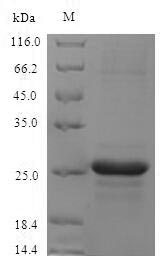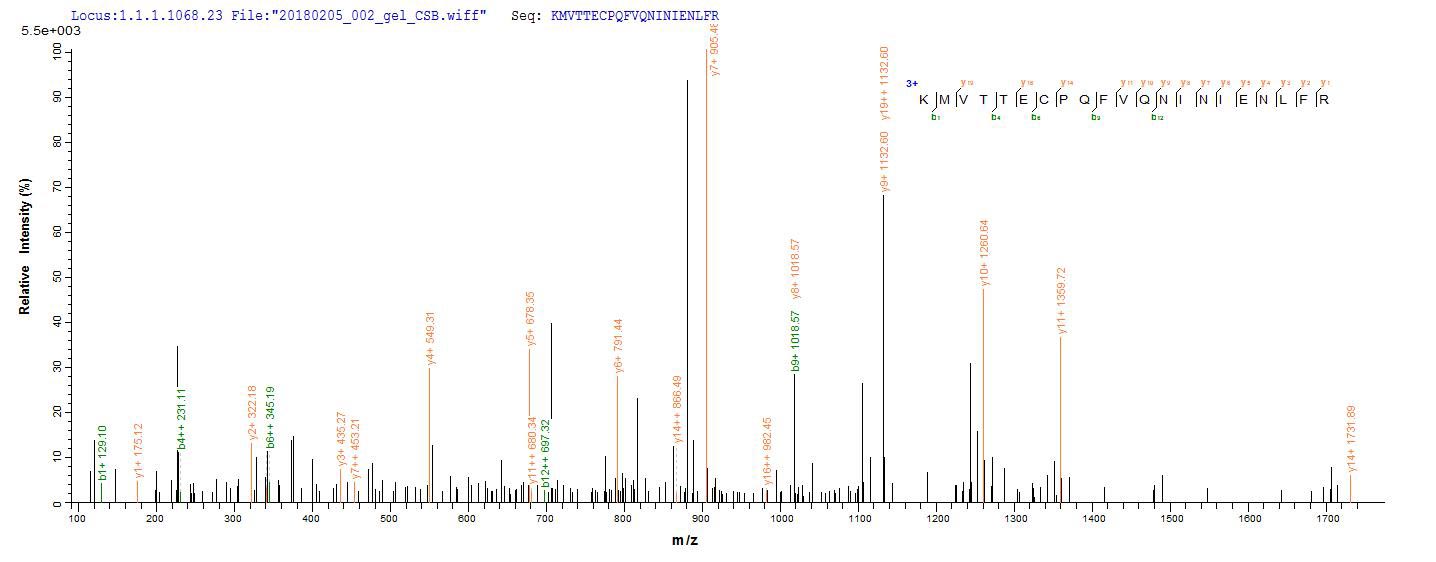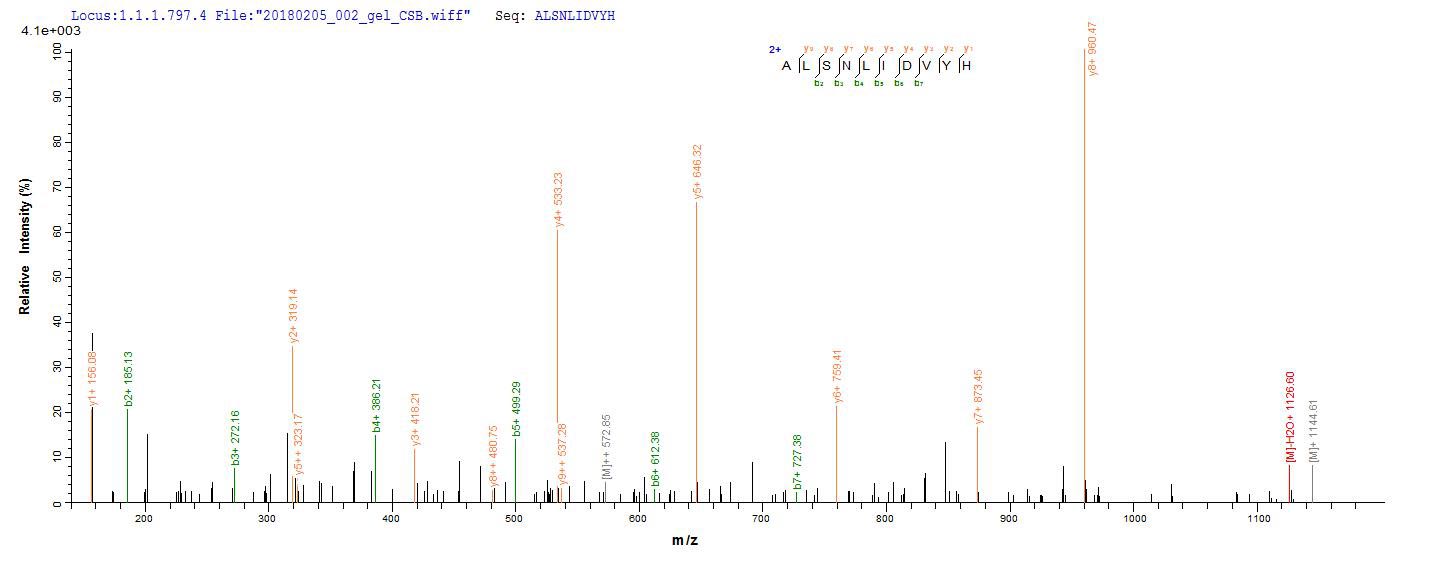Recombinant Mouse Protein S100-A8 (S100a8)
In Stock Promotion-
货号:CSB-EP020641MO
-
规格:¥1836
-
促销:

-
图片:
-
(Tris-Glycine gel) Discontinuous SDS-PAGE (reduced) with 5% enrichment gel and 15% separation gel.
-
Based on the SEQUEST from database of E.coli host and target protein, the LC-MS/MS Analysis result of CSB-EP020641MO could indicate that this peptide derived from E.coli-expressed Mus musculus (Mouse) S100a8.
-
Based on the SEQUEST from database of E.coli host and target protein, the LC-MS/MS Analysis result of CSB-EP020641MO could indicate that this peptide derived from E.coli-expressed Mus musculus (Mouse) S100a8.
-
-
其他:
产品详情
-
纯度:Greater than 90% as determined by SDS-PAGE.
-
基因名:
-
Uniprot No.:
-
别名:S100a8; Caga; Mrp8; Protein S100-A8; Calgranulin-A; Chemotactic cytokine CP-10; Leukocyte L1 complex light chain; Migration inhibitory factor-related protein 8; MRP-8; p8; Pro-inflammatory S100 cytokine; S100 calcium-binding protein A8
-
种属:Mus musculus (Mouse)
-
蛋白长度:Full Length of Mature Protein
-
来源:E.coli
-
分子量:26.2kDa
-
表达区域:2-89aa
-
氨基酸序列PSELEKALSNLIDVYHNYSNIQGNHHALYKNDFKKMVTTECPQFVQNINIENLFRELDINSDNAINFEEFLAMVIKVGVASHKDSHKE
Note: The complete sequence including tag sequence, target protein sequence and linker sequence could be provided upon request. -
蛋白标签:N-terminal 6xHis-SUMO-tagged
-
产品提供形式:Liquid or Lyophilized powder
Note: We will preferentially ship the format that we have in stock, however, if you have any special requirement for the format, please remark your requirement when placing the order, we will prepare according to your demand. -
缓冲液:Tris-based buffer,50% glycerol
-
储存条件:Store at -20°C/-80°C upon receipt, aliquoting is necessary for mutiple use. Avoid repeated freeze-thaw cycles.
-
保质期:The shelf life is related to many factors, storage state, buffer ingredients, storage temperature and the stability of the protein itself.
Generally, the shelf life of liquid form is 6 months at -20°C/-80°C. The shelf life of lyophilized form is 12 months at -20°C/-80°C. -
货期:3-7 business days
-
注意事项:Repeated freezing and thawing is not recommended. Store working aliquots at 4°C for up to one week.
-
Datasheet & COA:Please contact us to get it.
相关产品
靶点详情
-
功能:S100A8 is a calcium- and zinc-binding protein which plays a prominent role in the regulation of inflammatory processes and immune response. It can induce neutrophil chemotaxis and adhesion. Predominantly found as calprotectin (S100A8/A9) which has a wide plethora of intra- and extracellular functions. The intracellular functions include: facilitating leukocyte arachidonic acid trafficking and metabolism, modulation of the tubulin-dependent cytoskeleton during migration of phagocytes and activation of the neutrophilic NADPH-oxidase. Activates NADPH-oxidase by facilitating the enzyme complex assembly at the cell membrane, transferring arachidonic acid, an essential cofactor, to the enzyme complex and S100A8 contributes to the enzyme assembly by directly binding to NCF2/P67PHOX. The extracellular functions involve proinflammatory, antimicrobial, oxidant-scavenging and apoptosis-inducing activities. Its proinflammatory activity includes recruitment of leukocytes, promotion of cytokine and chemokine production, and regulation of leukocyte adhesion and migration. Acts as an alarmin or a danger associated molecular pattern (DAMP) molecule and stimulates innate immune cells via binding to pattern recognition receptors such as Toll-like receptor 4 (TLR4) and receptor for advanced glycation endproducts (AGER). Binding to TLR4 and AGER activates the MAP-kinase and NF-kappa-B signaling pathways resulting in the amplification of the proinflammatory cascade. Has antimicrobial activity towards bacteria and fungi and exerts its antimicrobial activity probably via chelation of Zn(2+) which is essential for microbial growth. Can induce cell death via autophagy and apoptosis and this occurs through the cross-talk of mitochondria and lysosomes via reactive oxygen species (ROS) and the process involves BNIP3. Can regulate neutrophil number and apoptosis by an anti-apoptotic effect; regulates cell survival via ITGAM/ITGB and TLR4 and a signaling mechanism involving MEK-ERK. Its role as an oxidant scavenger has a protective role in preventing exaggerated tissue damage by scavenging oxidants. The iNOS-S100A8/A9 transnitrosylase complex is proposed to direct selective inflammatory stimulus-dependent S-nitrosylation of multiple targets such as GAPDH, ANXA5, EZR, MSN and VIM by recognizing a [IL]-x-C-x-x-[DE] motif; S100A8 seems to contribute to S-nitrosylation site selectivity.; (Microbial infection) Upon infection by murine coronavirus (MHV-A59), induces expansion of aberrant immature neutrophils in a TLR4-dependent manner.
-
基因功能参考文献:
- Specific NLRC4 activation in Mrp8 (+) cells (primarily neutrophil lineage) is sufficient to cause severe inflammatory disease. PMID: 29263322
- We present the reconstitution, purification, and characterization of mCP as well as the cysteine-null variant mCP-Ser. Apo mCP is a mS100A8/mS100A9 heterodimer, and Ca(II) binding causes two heterodimers to self-associate and form a heterotetramer PMID: 29659256
- S100A8 was required for laser-induced new collagen synthesis in skin cells. PMID: 29270708
- Chronic Pseudomonas aeruginosa biofilm infection reduces murine S100A8/ S100A9 expression and delays species-specific burn wound closure. PMID: 28645160
- data suggest that S100A8/A9 acts directly on BV-2 microglial cells via binding to TLR4 and RAGE on the membrane and then stimulates the secretion of proinflammatory cytokines through ERK and JNK-mediated NF-kappaB activity in BV-2 microglial cells. PMID: 28498464
- Like S100A8, S100A9 and S100A8/A9 reduced neutrophil influx in acute lung injury provoked by lipopolysaccharide (LPS) challenge. PMID: 28074060
- theses findings reveal unexpected gene expression differences between WT and KO mice at a young age (in the absence of physiological stress), and address the hypothesis that Mrp8 and Mrp14 accumulation promotes age-related inflammation PMID: 27224926
- S100A8 and S100A9 aggravate Coxsackievirus B3-induced myocarditis and might serve as therapeutic targets in inflammatory cardiomyopathies. PMID: 29158436
- Neutrophil-derived S100A8/A9 promotes thrombocytosis in diabetic mice PMID: 28504650
- Perinatal alarmins S100A8 and S100A9 specifically altered MyD88-dependent proinflammatory gene programs. S100 programming prevented hyperinflammatory responses without impairing pathogen defense. TRIF-adaptor-dependent regulatory genes remained unaffected by perinatal S100 programming and responded strongly to lipopolysaccharide, but were barely expressed. PMID: 28459433
- S100a8 upregulation triggers NF-kappaB signal pathway through RAGE and TLR4, in response to laser-induced dermis wound healing. PMID: 26914682
- Although MRP-8/-14 expression is highly increased in experimental, these proteins do not contribute to the pathogenesis in the effector phase of epidermolysis bullosa acquisita and bullous pemphigoid. PMID: 26692467
- TLR4, TLR2 also contributed to Mrp8-induced inflammatory response and tolerance. PMID: 26329314
- S100A8 appears to play a crucial role in the activation of the TLR4/MD-2 pathway and the promotion of a tumor growth-enhancing immune microenvironment. PMID: 26165843
- S100A8 is primarily produced from CXCR2-expressing CD11b(+)Gr-1(high) cells, and it upregulates TNF-alpha production in CD11b(+)F4/80(+) cells through cellular cross-talk, which is an important mechanism in the development of Nonalcoholic fatty liver disease PMID: 26608915
- Alarmins S100A8/S100A9 aggravate osteophyte formation in experimental osteoarthritis and predict osteophyte progression in early human symptomatic osteoarthritis. PMID: 25180294
- Inflammation-induced S100A8 promotes colorectal tumorigenesis by acting upstream to activate the Akt1-Smad5-Id3 axis. PMID: 26135667
- Data shows that S100A8/A9 plays a critical role during glomerulonephritis, exerting and amplifying autocrine and paracrine proinflammatory effects on bone marrow-derived macrophages, renal endothelial cells, and mesangial cells. PMID: 25759267
- S100A8 could be a chemokine of oocyte origin, which attracts ovarian somatic cells to form the primordial follicles. PMID: 25953201
- expression of S100A8 in the lungs may facilitate recruitment of MDSC, which may in turn aid in establishing a metastatic niche capable of suppressing a localized immune response. PMID: 25255046
- This paper found a novel activation mechanism of NK cells via S100A8/A9-RAGE signaling, which may open a novel perspective on the in vivo interaction between inflammation and innate immunity. PMID: 25911757
- data suggest that S100A8 exerts pro-inflammatory effect on the occurrence and development of neuro-inflammation and postoperative cognitive dysfunction by activating TLR4/MyD88 signaling in the early pathological process of the postoperative stage. PMID: 25449673
- S100A8 and S100A9 initiate the early inflammatory program in injured peripheral nerves PMID: 25792748
- Time-lapse intravital multiphoton imaging of adipose tissues identified the very early event exhibiting increased mobility of macrophages, which may be triggered by increased expression of adipose S100A8. PMID: 25848057
- Myocardial gene and protein expression of S100A8 was also significantly increased in mice 1 day after debanding that had been preceded by 3 days or 1 week of transverse aortic constriction. PMID: 25820336
- THC-induced myeloid-derived suppressor cells secreted elevated levels of S100A8. Neutralization of S100A8 in vivo reduced the ability of THC to trigger MDSCs. High S100A8 expression also promoted their suppressive function. PMID: 25713087
- Calprotectin heterodimer of subunits S100A8 (and S100A9 ) is detectable within 6 h of infection as immune cells respond to the invading pathogen. PMID: 23754577
- Myeloid-related proteins 8 and 14 contribute to monosodium urate monohydrate crystal-induced inflammation in gout. PMID: 24470119
- S100A8/A9 expression in the skin epidermal layer has a role in controlling skin tumor formation PMID: 24436096
- Data indicate that angiotensin II infusioni increased expression of S100a8/a9 in the heart. PMID: 24711518
- S100a8 and S100a9, associated with immune responses, were common differentially expressed genes in a mouse model of hereditary hemochromatosis. PMID: 24338419
- These results suggest that S100A8 alarmin is sufficient, but not necessary, to induce polymorphonuclear neutrophil migration during vulvovaginal candidiasis and this responseinvolves pattern recognition receptors. PMID: 24478092
- depletion increased Pseudomonas aeruginosa burden in flagellin-pretreated corneas PMID: 23340821
- These results suggest that rapid secretion of MRPs by neutrophils at the site of infection may protect uninfected macrophages and favor a more efficient innate inflammatory response against Leishmania infection. PMID: 24086787
- High levels of S100A8/A9 proteins aggravate ventilator-induced lung injury via TLR4 signaling. PMID: 23874727
- S100A8 and ephrin-A1 contribute to lung metastasis. PMID: 24103748
- Our study demonstrated a dual role for MRP8/14 in bacterial keratitis. PMID: 23299480
- results identify MRP8/14 as key player in protective innate immunity during Klebsiella pneumonia PMID: 23133376
- Mrp8, the active component of the heterocomplex, inhibits early dendritic cells (DCs) maturation and antigen presentation in a TLR-4-dependent manner. PMID: 23188082
- S100A8 and S100A9 proteins are crucially involved in synovial activation and cartilage destruction during osteoarthritis. PMID: 22143922
- S100A8 and S100A9 were specifically induced by LPS in the salivary glands. PMID: 21125321
- sustained activation of S100A8/A9 critically contributes to the development of post-ischemic heart failure (HF) driving the progressive course of HF through activation of RAGE. PMID: 22318783
- Targeted imaging with myeloid-related protein 8/14 via gadolinium immunonanoparticles demonstrates enhancement of plaque with binding to inflammatory cells and reduction in inflammation. PMID: 22308043
- S100a8, without S100a9, has a previously unrecognized role in embryo development. S100a8 also has a second role in the maternal deciduum, where expression is associated with the vasculature from the E8.5 stage to the formation of mature placenta. PMID: 22016186
- The calcium-binding proteins myeloid-related protein (MRP)-8 (S100A8) and MRP-14 (S100A9) form MRP-8/14 heterodimers (S100A8/A9, calprotectin) that regulate myeloid cell function and inflammatory responses in graft rejectionl PMID: 22144572
- Rab30 and S100a8/S100a9 were indicated to play roles in the initiation of liver regeneration as well as possibly in the functional switch of the liver in the newborn stage. PMID: 21308349
- These results thus reveal a novel role for myeloid-derived S100A8/A9 in activating specific downstream genes associated with tumorigenesis and in promoting tumor growth and metastasis. PMID: 21228116
- These results demonstrate that S100A8 stimulated osteoclast formation and activity and suggest that both S100A8 and TLR-4 are important factors in mediating osteoclastic bone destruction in experimental arthritis. PMID: 21337316
- The results may provide important information for the expression of s100a8/a9 and RAGE, linking progressive cystogenesis with inflammation in cystic kidney. PMID: 20606421
- Chondrocyte derived S100A8 and S100A9 may have a sustained role in cartilage degradation in inflammatory arthritis PMID: 20105291
显示更多
收起更多
-
亚细胞定位:Secreted. Cytoplasm. Cytoplasm, cytoskeleton. Cell membrane; Peripheral membrane protein. Note=Predominantly localized in the cytoplasm. Upon elevation of the intracellular calcium level, translocated from the cytoplasm to the cytoskeleton and the cell membrane. Upon neutrophil activation or endothelial adhesion of monocytes, is secreted via a microtubule-mediated, alternative pathway.
-
蛋白家族:S-100 family
-
数据库链接:
KEGG: mmu:20201
STRING: 10090.ENSMUSP00000064385
UniGene: Mm.21567
Most popular with customers
-
Recombinant Macaca fascicularis Trophoblast glycoprotein (TPBG), partial (Active)
Express system: Mammalian cell
Species: Macaca fascicularis (Crab-eating macaque) (Cynomolgus monkey)
-
Recombinant Human Glucagon-like peptide 1 receptor (GLP1R), partial (Active)
Express system: Mammalian cell
Species: Homo sapiens (Human)
-
Recombinant Human Interleukin-2 (IL2) (Active)
Express system: Mammalian cell
Species: Homo sapiens (Human)
-
Recombinant Human Transmembrane 4 L6 family member 1(TM4SF1)-VLPs (Active)
Express system: Mammalian cell
Species: Homo sapiens (Human)



















